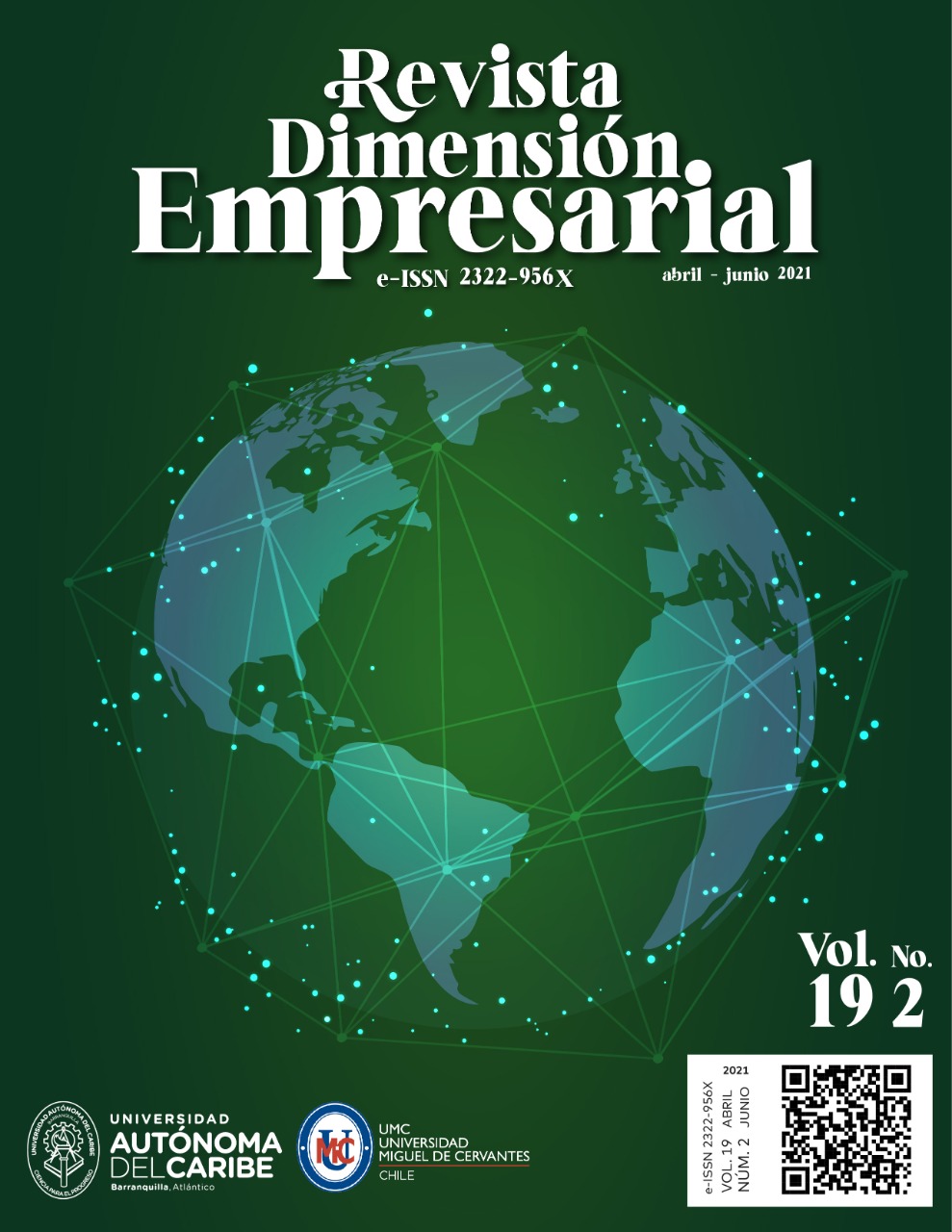Metodología multicriterio para la identificación y clasificación de partes interesadas pertinentes
DOI:
https://doi.org/10.15665/dem.v19i2.2688Palabras clave:
Partes interesadas pertinentes, Análisis multicriterio, Modelo de Mitchell, Proceso Analítico JerárquicoResumen
El análisis de partes interesadas pertinentes es un tema complejo debido al gran número de variables
involucradas. En este artículo se desarrolla una metodología
multicriterio para la identificación y clasificación de partes interesadas pertinentes, integrando el análisis PESTEL, el modelo de Mitchell y el proceso analítico jerárquico (AHP). La metodología fue aplicada en un caso real y se verificó su adecuado funcionamiento, clasificando como pertinentes el 38% de las partes interesadas identificadas. Los resultados de la aplicación de la metodología permiten priorizar las iniciativas gerenciales en aquellas partes interesadas que pueden afectar el desempeño de las operaciones y el logro de los objetivos organizacionales.
Citas
Aapaoja, A. (2014). A Framework for Stakeholder Identification and Classification in Construction Projects. Open Journal of Business and Management, 02(01), 43–55. https://doi.org/10.4236/ojbm.2014.21007
Bourne, L., & Walker, D. H. T. (2005). Visualising and mapping stakeholder influence. Management Decision, 43(5), 649–660. https://doi.org/10.1108/00251740510597680
Cardozo, J. I. (2018). Necesidades insatisfechas de una comunidad aledaña a una terminal portuaria de Barranquilla. https://doi.org/10.14482/pege.45.11047
Chung, K. S. K., & Crawford, L. (2016). The Role of Social Networks Theory and Methodology for Project Stakeholder Management. Procedia - Social and Behavioral Sciences, 226(October 2015), 372–380. https://doi.org/10.1016/j.sbspro.2016.06.201
Coble, Y., & Coussens, C. (2009). Environmental Health Sciences Decision Making (National A). National Academies Press. https://doi.org/10.17226/12444
Escobar, J. W. (2015). Metodología para la toma de decisiones de inversión en portafolio de acciones utilizando la técnica multicriterio AHP. Contaduría y Administración, 60(2), 346–366. https://doi.org/https://doi.org/10.1016/S0186-1042(15)30004-8
Ferretti, V. (2016). From stakeholders analysis to cognitive mapping and Multi-Attribute Value Theory: An integrated approach for policy support. European Journal of Operational Research, 253(2), 524–541. https://doi.org/10.1016/j.ejor.2016.02.054
Freeman, E. (2010). Strategic management: A stakeholder approach (Cambridge). Cambridge. https://books.google.com.co/books?hl=es&lr=&id=NpmA_qEiOpkC&oi=fnd&pg=PR5&dq=Strategic+management:+A+stakeholder+approach&ots=61clF6N5ON&sig=0JkoXDmB8vskxnCsurBtsuBF5Wo&redir_esc=y#v=onepage&q=Strategic%20management%3A%20A%20stakeholder%20approach&f=false
Friedman, A. L., & Miles, S. (2002). Developing Stakeholder Theory. Journal of Management Studies, 39(1), 1–21. https://doi.org/10.1111/1467-6486.00280
Hester, P. (2015). Analyzing Stakeholders Using Fuzzy Cognitive Mapping. Procedia Computer Science, 61, 92–97. https://doi.org/10.1016/j.procs.2015.09.159
Higgins, M., & Benaroya, H. (2020). Utilizing the Analytical Hierarchy Process to determine the optimal lunar habitat configuration. Acta Astronautica, 173(January), 145–154. https://doi.org/10.1016/j.actaastro.2020.04.012
Kennon, N., Howden, P., & Hartley, M. (2009). Who really matters? A stakeholder analysis tool. Extension Farming Systems Journal, 5(2), 9–17. https://www.csu.edu.au/__data/assets/pdf_file/0018/109602/EFS_Journal_vol_5_no_2_02_Kennon_et_al.pdf
Liang, Y., Guo, P., Zhu, Y., & Gui, Q. (2011). Identification of stakeholders for the brownfield redevelopement based on grey correlation. Proceedings of 2011 IEEE International Conference on Grey Systems and Intelligent Services, GSIS’11 - Joint with the 15th WOSC International Congress on Cybernetics and Systems, 390–393. https://doi.org/10.1109/GSIS.2011.6044032
Mareschal, B., & De Smet, Y. (2009). Visual promethee: developments of the promethee & gaia multicriteria decision aid methods. IEEM 2009 - IEEE International Conference on Industrial Engineering and Engineering Management, 2, 1646–1649. https://doi.org/10.1109/IEEM.2009.5373124
Olander, S., & Landin, A. (2005). Evaluation of stakeholder influence in the implementation of construction projects. International Journal of Project Management, 23(4), 321–328. https://doi.org/10.1016/j.ijproman.2005.02.002
Osorio, J. (2008). EL Proceso de Análisis Jerárquico (AHP) y la toma de decisiones multicriterio. Ejemplo de aplicación. Scientia Et Technica, XIV(39), 247–252. https://doi.org/10.22517/23447214.3217
Savage, G. T., Nix, T. W., Whitehead, C. J., & Blair, J. D. (1991). Strategies for assessing and managing organizational stakeholders. Academy of Management Perspectives, 5(2), 61–75. https://doi.org/10.5465/ame.1991.4274682
Schuetz, C. G., Mair, E., & Schrefl, M. (2018). PESTEL Modeler: Strategy Analysis Using MetaEdit+, iStar 2.0, and Semantic Technologies. Proceedings - IEEE International Enterprise Distributed Object Computing Workshop, EDOCW, 2018-Octob, 216–219. https://doi.org/10.1109/edocw.2018.00040
Wang, J., Ge, J., & Lu, Q. (2012). A review of stakeholder analysis. 2012 3rd International Conference on System Science, Engineering Design and Manufacturing Informatization, 2, 40–43. https://doi.org/10.1109/icssem.2012.6340802
Yannis, G., Kopsacheili, A., Dragomanovits, A., & Petraki, V. (2020). State-of-the-art review on multi-criteria decision-making in the transport sector. Journal of Traffic and Transportation Engineering (English Edition), 7(4), 413–431. https://doi.org/https://doi.org/10.1016/j.jtte.2020.05.005
Zhou, S., & Yang, P. (2020). Risk management in distributed wind energy implementing Analytic Hierarchy Process. Renewable Energy, 150, 616–623. https://doi.org/10.1016/j.renene.2019.12.125
Descargas
Publicado
Cómo citar
Número
Sección
Licencia
Derechos de autor 2021 Juan M. Cogollo-Florez, Ana C. Restrepo-Olarte

Esta obra está bajo una licencia internacional Creative Commons Atribución-NoComercial-SinDerivadas 4.0.
Tenga en cuenta que al presionar el botón "guardar y continuar" que está al final, Usted está asumiendo todos los compromisos éticos y legales que aquí se enuncian. Ellos establecen las responsabilidades de la legislación en materia de derechos de propiedad intelectual. Para esto se asume que quien está efectuando la acción de presentar el escrito obra de buena fe y se representa a sí mismo y a los demás autores del artículo postulado.
En este sentido, los autores conservan todos los derechos de los cuales son titulares y autorizan la reproducción gratuita del documento enviado. En el evento de ser necesario, asumirán, al presionar el botón "guardar y continuar", la responsabilidad legal derivada de los derechos patrimoniales los cuales son gratuitos en razón al no cobro por ningún procedimiento de la Revista.
En consecuencia, El(Los) autor(es) representados por quien adelanta la postulación del artículo a evaluación y eventual publicación,
Declaro(amos):
1. Que soy (somos) el (los) autor(es) del artículo {aquí va el nombre del artículo colocado automáticamente}.
2. Que ésta es una obra original conforme a la ley de propiedad intelectual de derechos de autor colombiana.
3. Que el contenido del artículo de la referencia no ha sido publicado y que no se presentará a ningún otro medio de publicación en soporte escrito o electrónico antes de conocer la decisión del Comité Editorial de Dimensión Empresarial.
4. Que el firmante de esta certificación garantiza que el compromiso que aquí adquiere no infringe ningún tipo derechos de terceros.
5. Que la autorización de publicación incluye su archivo electrónico y su adaptación, de ser necesario, para su incorporación en la red o en cualquier formato electrónico o base de datos, así como anexar los metadatos necesarios para realizar el registro de la obra, marcas de agua o cualquier otro sistema de seguridad o de protección.
6. Que la autorización de publicación incluye la reproducción en soportes digitales. Así como su distribución y la puesta a disposición a través de archivos institucionales a través de Internet, distribuir copias, y exhibirlo en Colombia y fuera del país, así como incluir el artículo en índices nacionales e internacionales.
7. Que el autor asume toda la responsabilidad, incluyendo las indemnizaciones por daños, que pudieran ejercitarse contra la Universidad Autónoma del Caribe por terceros que vieran infringidos sus derechos e intereses a causa de la cesión.
Por su parte, Dimensión Empresarial se obliga a respetar, en todo caso, los derechos del autor contenido en el artículo 30 de la Ley 23 de 1982, o cualquiera posterior a esta y pondrá el artículo a disposición de los usuarios de la Revista para que hagan un uso legítimo de él, según lo permitido por la legislación aplicable, siempre que se cite su autoría, no se obtenga beneficio comercial, y no se realicen obras derivadas.
Los autores/as se comprometen a aceptar las condiciones de esta nota de propiedad intelectual, que se aplicarán a este envío cuando sea publicado en esta revista (más abajo se pueden añadir comentarios al editor/a).




